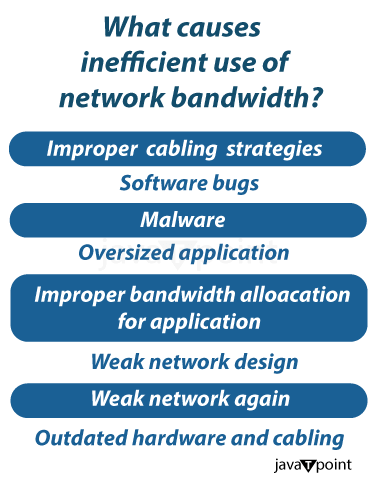8 Tips to Optimize network bandwidth and PerformanceIntroductionIn order to facilitate business objectives and mission-critical applications, enterprise networks need to have enough bandwidth. However, there are a number of factors that can make it difficult to use that bandwidth effectively. The maximum amount of data that a network connection can send over a link is measured by its bandwidth. Nevertheless, bandwidth does not equate to speed. Throughput is a term used to describe the speed at which data is transferred. Even though network administrators try their best to estimate the requirement for bandwidth and plan capacity for their organization's networks, problems frequently crop up that gobble up bandwidth and impede traffic flow. These slowdowns can impair performance, degrade the user experience, and even result in revenue loss. Network teams should respond by being proactive in monitoring and improving network performance and bandwidth utilization. Factors that hamper efficient use of network bandwidthArchitects and Network administrators plan their networks to have enough bandwidth. However, a network may not use the bandwidth effectively, even if it has sufficient capacity. Network bottlenecks and congestion occur much too frequently, resulting in packet loss, latency problems, and slower response times. 
The following are some elements that lead to inefficient utilization of network bandwidth:
Though they might not appear debilitating, sporadic slow network connections can negatively impact the user experience and reduce expenses for businesses. Use the the following calculation to find the cost of a slow network in a year: 
Cost = Lost productivity per year in hours x Average hourly wage x Number of employees on network
How to optimise the network bandwidthNetwork teams are understandably concerned about not having sufficient bandwidth to support the apps and users on their networks when evaluating bandwidth requirements. However, network administrators also take care to prevent overspending on bandwidth, as this could result in the company paying for capacity that is not required. Here are eight techniques that network teams can employ to more effectively allocate and utilise bandwidth. 
1. Collect network data and establish baselinesWithout properly evaluating the network, it is hard to determine where bandwidth enhancements should be made. Gathering and analyzing network data to understand how applications and users use bandwidth is one of the first things network administrators can do. Teams are able to profile an application's functionality, usage patterns, and degree of compliance with end-user requirements. Network administrators should also keep an eye on the origins and destinations of traffic, analyzing both internal and external flow patterns. It is beneficial for teams to identify peak times rather than focusing on averages of data and bandwidth usage. Teams must take into consideration business functions that necessitate rapid rises in bandwidth use, like end-of the month tasks, accounting closure procedures, payroll, or periods of elevated client demand. A variety of tools, such as network management and monitoring platforms, visibility and analytics software, network packet brokers, and the Simple Network Management Protocol, can be used by teams to collect this data. Network teams can create a baseline for bandwidth usage by collecting and analyzing this data. These baselines help define security policies and provide a standard for network performance and configuration modifications in the future. Teams can also examine the network infrastructure, which includes the electronics, switch ports, and cabling. 2. Map out network topologyTeams can map out the current network topology after determining the baseline bandwidth utilization in their network. Teams can monitor how traffic moves between users and apps on the network, as well as how devices are connected, because of this procedure. Teams may find that delays and bottlenecks usually happen along particular routes, and they can evaluate how to rework their design to decrease that congestion. Another possibility is that a network is operating on a legacy topology that is unable to keep up with the expansion of cloud services, apps, and inbound traffic. Teams in this situation need to assess whether to use a new network topology design. 3. Assess VLAN and subnetsTeams can evaluate their network's VLANs and subnets after analyzing their topologies. Teams can divide up the network into segments and organise communication between endpoints in those segments more easily with the help of subnets and VLANs. To comply with stricter security and compliance regulations, network administrators might designate a separate VLAN for the financial department, as well as other ones for customer support, sales, and HR. The endpoints in these segments transport data mostly inside their group, although they can also communicate with other endpoints within their VLAN or subnet. By reducing unnecessary traffic, this lowers the total amount of bandwidth used throughout the network. Subnets and VLANs can provide an additional degree of security and redundancy. 4. Use load balancing and cachingThrough the efficient use of bandwidth, services such as load balancing and load sharing can enhance performance by distributing traffic among several network paths, through the monitoring of several connections, load balancing helps the network effectively direct packets and handle unexpected overloads in traffic. Additionally, network teams can use link aggregation and caching to transport packets across several connections quickly and remove the need for unnecessary data retrieval. 5. Set up policies and prioritizationNetwork teams can assess which users, resources, and applications require bandwidth priority by using the gathered data and baselines that have been set. Admins want to give top priority to real-time apps that are vital to the business, such as video, VoIP, and collaboration tools. Teams should prepare for the possibility of high bandwidth demand for certain applications. Network administrators can also set up policies that block access to specific resources, mail attachments, and websites that use a lot of bandwidth, like Netflix. Administrators can eliminate or restrict access to resources that are consuming excessive bandwidth by employing monitoring tools to identify which resources are consuming it. Quality of service (QoS) and traffic shaping are two more techniques for managing bandwidth. Traffic shaping gives priority to mission-critical packets while they travel the network. To prevent resource depletion and bandwidth competition, teams can set up QoS attributes in their applications. 6. Time network upgradesScheduling network upgrades, configuration modifications, backups, and patches for periods when users are less likely to be on the network is another practical method for maximising network capacity. For example, administrators can arrange for backups to occur during the overnight hours. Another factor to evaluate is which devices or operating systems have automatic update settings. 7. Implement monitoring toolsNetwork admins can identify congested routes and apps using excessive bandwidth by using monitoring tools. They offer helpful data on a variety of indications, including alerting, intrusion detection, device inventory, performance, and status. While restricting the amount of bandwidth they need to collect that data, administrators can adjust their monitoring systems to prioritise the data they want for the most pertinent and useful insights. Think about the following elements, for instance:
Configuring network monitoring tools properly is essential to ensuring optimal performance and minimal bandwidth usage. Depending on available bandwidth and the value of real-time network updates, administrators can choose how much bandwidth to utilize for their monitoring platforms. Teams that monitor thousands of devices over a wide area network (WAN) won't need the same amount of bandwidth as those that get connectivity and performance data from a single-core router every ten seconds. The following are a few best practices for allocating bandwidth for monitoring tools:
8. Look to the futureFinally, teams need to plan for any changes they may experience over the next few years, including upgrades to servers, hardware, memory, and operating systems; application modifications; and cloud migration. Consider how these modifications may affect traffic growth, security requirements, and routing policies. Although the future is unpredictable, network teams can more effectively manage their bandwidth utilization and network performance by creating a reliable and adaptable plan.
Next TopicAsymmetric Communications
|
 For Videos Join Our Youtube Channel: Join Now
For Videos Join Our Youtube Channel: Join Now
Feedback
- Send your Feedback to [email protected]
Help Others, Please Share










